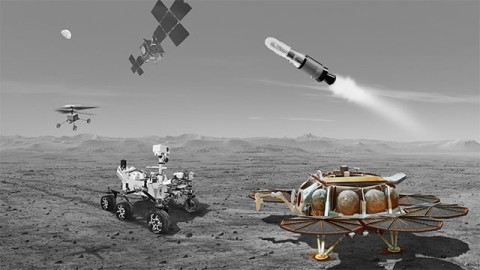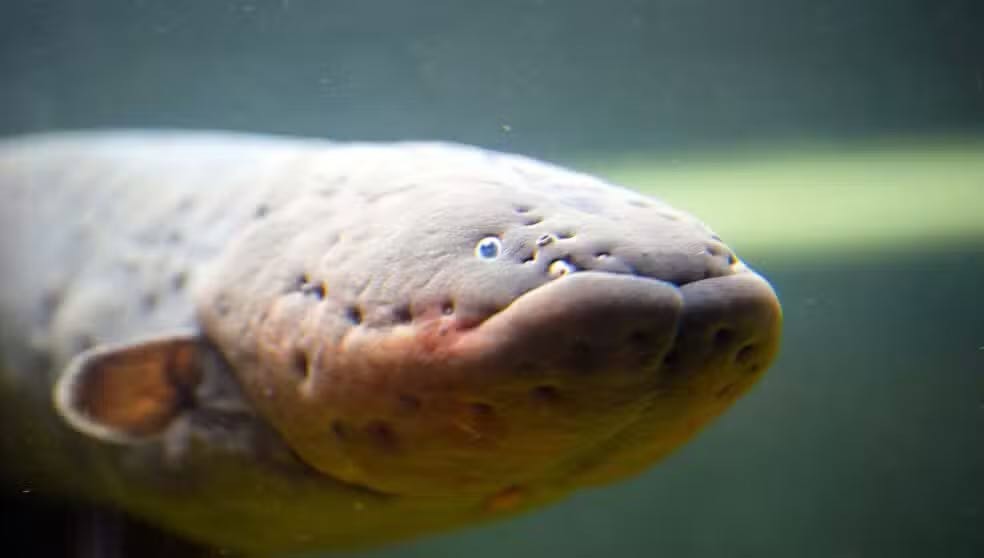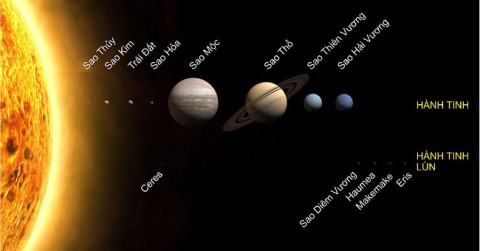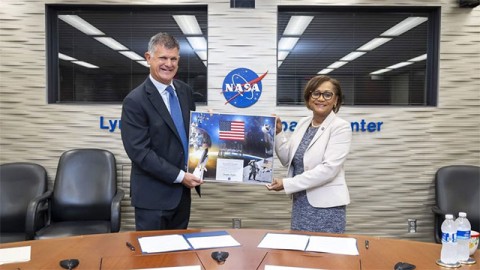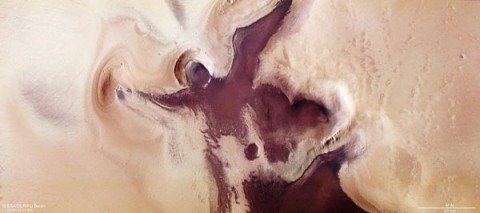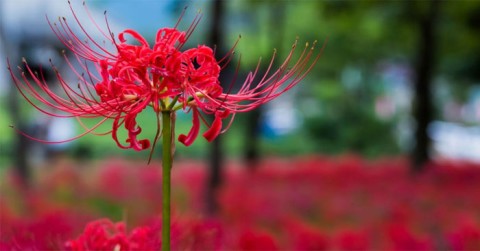Enjoy this 2.5 billion pixel photo of a detailed panorama of Mars
On September 14, NASA shared the most detailed image of the surface of Mars ever, along with a video that gives us a new and clearest panoramic view of the surface of the red planet.
Mars is one of the most interesting planets. Here are some little known facts about Mars.
The red planet Mars, named after the Roman god of war, has long been a harbinger in the night sky. And in its own way, the planet's rusty red surface tells a tale of destruction. Billions of years ago, the fourth planet from the sun may have been mistaken for Earth's smaller twin, with water on its surface—and possibly even life.
Today, the world is a cold, barren desert with little sign of water. But decades of research by orbiters, landers, and rovers have revealed that Mars has a vibrant, windswept landscape that could—perhaps—harbor microbial life beneath its rusty surface. Here are some facts you might not know about Mars.
 Photo credit: Diana Yukari/Business Insider
Photo credit: Diana Yukari/Business Insider
We humans have sent dozens of probes and satellites to the Red Planet - Mars over the past decades.
These spacecraft have transmitted impressive images, inspired sci-fi movies like " The Martian ," and even inspired Elon Musk's idea of colonizing the Red Planet.
But how many facts do we know about our " neighbor " right next to planet Earth?
Although humans have not yet set foot on this place, there are still many mysteries to be solved, scientists have found many interesting things about Mars.
From what it's like on Earth's surface to the most impressive locations to the presence of an ancient ocean ( and tsunamis ), read on to discover 12 interesting facts about Mars you may not know!
Surface area of Mars
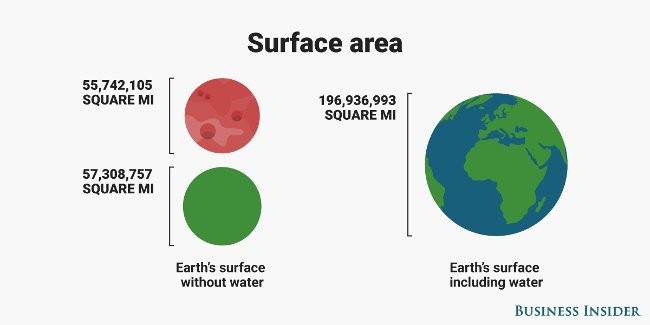 Photo credit: Diana Yukari/Business Insider
Photo credit: Diana Yukari/Business Insider
The surface area of Mars is only slightly smaller than the total land area on Earth — but that's not counting the 71% of Earth that's covered in water.
See also: Revealing the best place to find life on Mars
Mars temperature
 Photo credit: Diana Yukari/Business Insider
Photo credit: Diana Yukari/Business Insider
Among the planets in the Solar System, the seasons on Mars are most similar to those on Earth, due to the nearly equal tilt of the two planets' rotation axes. Seasons on Mars are about twice as long as on Earth, due to the greater distance from the Sun, resulting in a year on the Red Planet lasting about two Earth years . Temperatures on Mars range from a low of −87 °C during the polar winter to −5 °C in the summer. The average surface temperature on Mars is −81 °F, lower than the average temperature on Earth of 138 °C .
Mars atmosphere
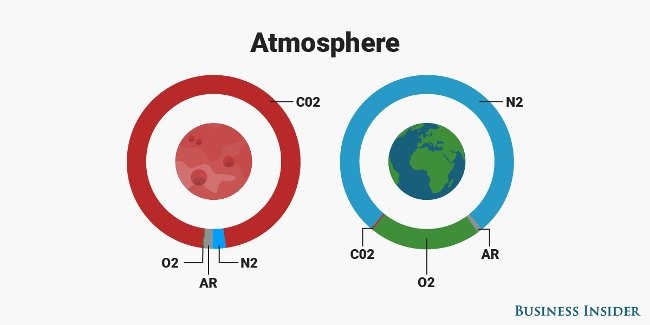 Photo credit: Diana Yukari/Business Insider
Photo credit: Diana Yukari/Business Insider
The Martian atmosphere is 95% carbon dioxide, 3% nitrogen, 1.6% argon, and contains traces of oxygen and water vapor. The Red Planet's atmosphere is quite dusty, containing dust particles about 1.5 µm in diameter, giving the Martian sky a yellow-brown color when viewed from its surface.
The Martian atmosphere is 61 times thinner than Earth's, and it consists almost entirely of carbon dioxide, which makes up just 0.04% of Earth's atmosphere.
Canyon
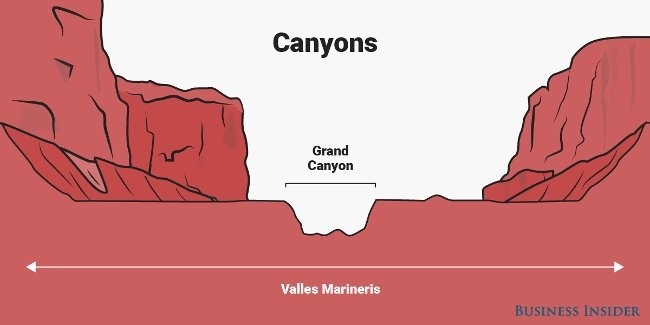 Photo credit: Diana Yukari/Business Insider
Photo credit: Diana Yukari/Business Insider
Mars has Olympus Mons , the highest mountain in the Solar System, and Valles Marineris , the deepest and widest canyon in the Solar System, five times the deepest canyon on Earth. Not only does it surpass the world's deepest canyon, the Grand Canyon in the United States, Valles Marineris is also considered the deepest canyon in the Solar System, including Earth. The flat Borealis basin in the northern hemisphere covers up to 40% of the Red Planet's surface and may have been a giant impact crater in the past.
Ancient Ocean
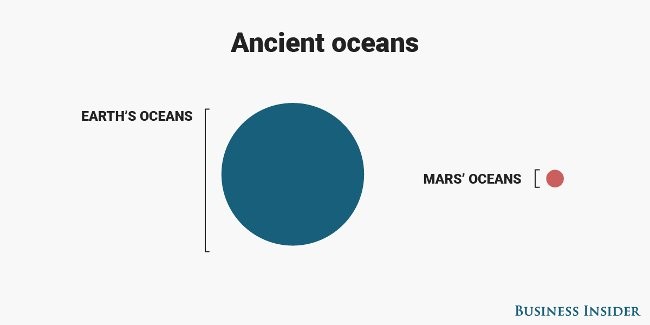 Photo credit: Diana Yukari/Business Insider
Photo credit: Diana Yukari/Business Insider
The Red Planet Mars once had oceans, but adding oceans would only add 1.5% of Earth's water.
Oasis
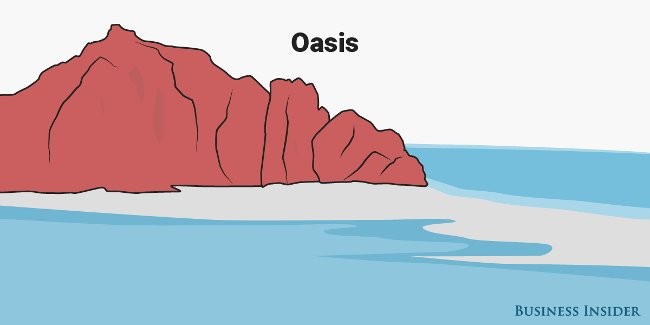 Photo credit: Diana Yukari/Business Insider
Photo credit: Diana Yukari/Business Insider
If aliens existed on Mars, they may have lived in oasis-like lakes. These lakes could have supported life, just as they do on Earth.
See also: Science experiment: Potatoes can be grown on Mars
Tsunami
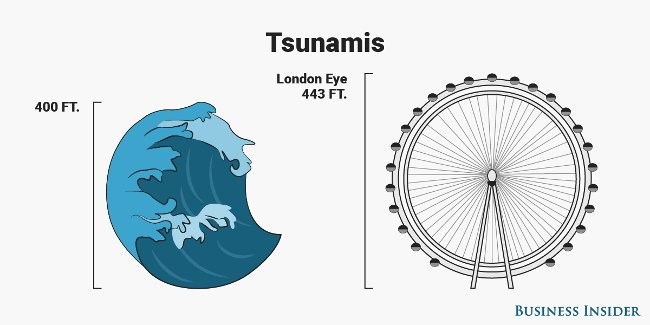 Photo credit: Diana Yukari/Business Insider
Photo credit: Diana Yukari/Business Insider
The Martian oceans also have tsunamis just like those on Earth. The highest tsunamis can reach heights of 400 ft ~ 122 meters, just a little shorter than the London Eye or the Millennium Wheel.
Ice cap
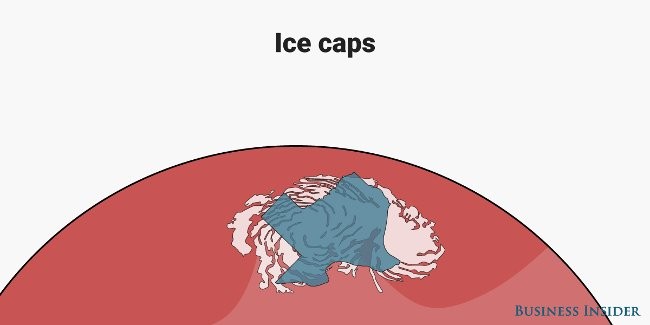 Photo credit: Diana Yukari/Business Insider
Photo credit: Diana Yukari/Business Insider
Like planet Earth, Mars has ice caps at the poles. The northern ice cap is up to 2 miles deep and covers an area slightly larger than the state of Texas. ( Texas is one of the states in the central southwestern United States .)
Volcano
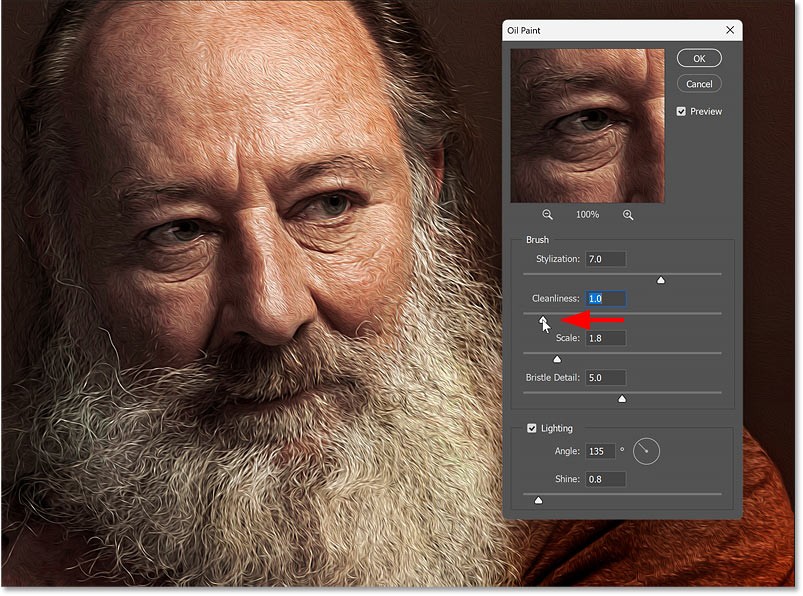 Photo credit: Diana Yukari/Business Insider
Photo credit: Diana Yukari/Business Insider
Olympus Mons ( Latin for Mount Olympus ) is a large volcano on Mars. It is 25 km high, three times higher than Mount Everest and is the tallest mountain in the Solar System. Olympus Mons is twice as tall as Earth's largest volcano, Mauna Loa in Hawaii.
See also: Learn the secret of Mars' formation
Zoom ratio
 Photo credit: Diana Yukari/Business Insider
Photo credit: Diana Yukari/Business Insider
Missions to Mars have become much rarer – after 23 launches in the 1960s and 1970s , we have only conducted 10 launches in the new millennium ( so far ).
Mission
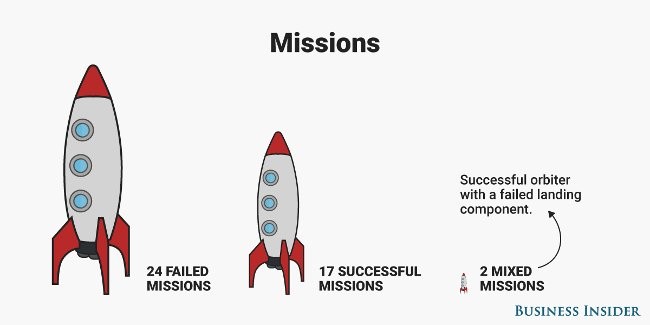 Photo credit: Diana Yukari/Business Insider
Photo credit: Diana Yukari/Business Insider
Missions to Mars are notoriously difficult to accomplish: About one-third of all launches have failed.
Coming soon
 Photo credit: Diana Yukari/Business Insider
Photo credit: Diana Yukari/Business Insider
Mark your calendars - Mars New Year will be March 23, 2019.
54 More Interesting Facts About Mars
Until now, the vast universe still contains many mysteries that modern science has not yet discovered. Among them is Mars - the Red Planet - one of the planets that we can sometimes observe with the naked eye when standing on Earth. Below are the most interesting facts about the planet Mars that will surely surprise you.

1. Of all the planets in the Solar System , Mars is the one that many scientists believe is likely to support life.
2. A Martian day is longer than an Earth day. An Earth day is 23 hours and 56 minutes, while a Martian day is 24 hours, 39 minutes, and 35 seconds .
3. The surface of Mars is similar to the surface of Earth, also made up of frozen carbon dioxide and a small amount of water.
4. Scientists believe that Mars was once surrounded by flowing water like Earth and may have also had a blue sky .
5. Mars also has four seasons a year like Earth, which means when Earth is tilted 23.5 0, Mars is tilted 25.19 0.
6. When observed from Earth, the size of the Sun is only half the size of Mars.
7. The rocks from Mars that fall to Earth are fragments from meteorite collisions in space.

8. The planet Mars was named after the Roman God of War , because it is the color of blood.
9. In Greek mythology, Mars is called Ares .
10. Only 1/3 of missions to Mars are successful.
11. Mars is often called the " red planet " because the surface of Mars is red.
12. Scientists first discovered possible water on the surface of Mars in 1971, when they discovered large volcanoes on its surface. This suggested that the planet Mars was capable of heating but not retaining enough heat to support life.
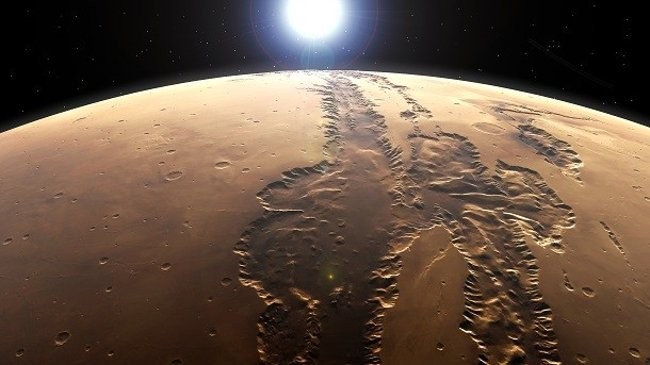
13. The ancient Romans and Egyptians studied the sky and realized that Mars was a planet similar to Earth. They, along with the people living in the city of Babylon, showed that Mars was farther from the Sun than Earth.
14. The reason why Mars is red is because its surface contains iron oxide , which we commonly refer to as " rust ". That is what gives the planet Mars its red appearance.
15. This planet has a crust that is about 50km to 125km thick depending on the location. It is about 40km thicker than Earth's crust.
16. The lack of vegetation suggests that Mars is a planet prone to dust storms . These storms are similar to those that occur on Earth and are likely to cause soil erosion over time.
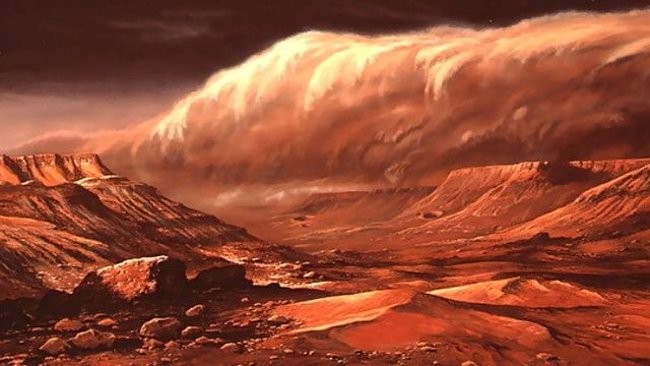
17. Mars is 141 million miles ( equivalent to 226,917,504 km ) from the Sun.
18. Mars, like Earth, is poorly protected from ultraviolet radiation.
19. Year-round temperatures range from -140 0 C to 70.7 0 C.
20. Mars is only 1/10 the size of Earth with a density of 3,933 grams/cm 3.
21. Because of its smaller mass, Mars' gravity is also lower than Earth's. This means that a person or object weighing 45kg on Earth would only weigh 17kg on Mars.
22. If the Statue of Liberty were built on Mars exactly like it is on Earth, it would weigh 84,825 kg less than it would on Earth.
23. Mars' gravity is only 1/3 of Earth's, which means you can jump 3 times higher than normal.
24. One year on Mars is equal to 687 Earth days .
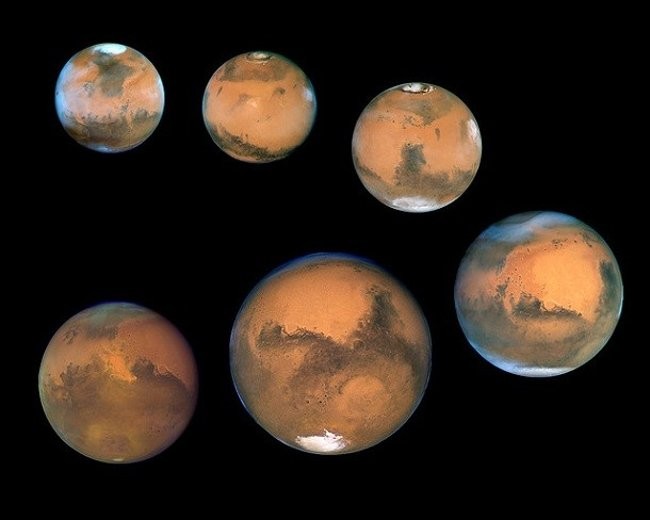
25. Mars has four seasons just like Earth, except that the seasons are twice as long. This means that Mars has a yearly cycle that humans can understand and adapt to.
26. Venus is more likely to support life than Mars.
27. In 1970, the Viking probe captured images of pyramids and giant faces on the surface of Mars.
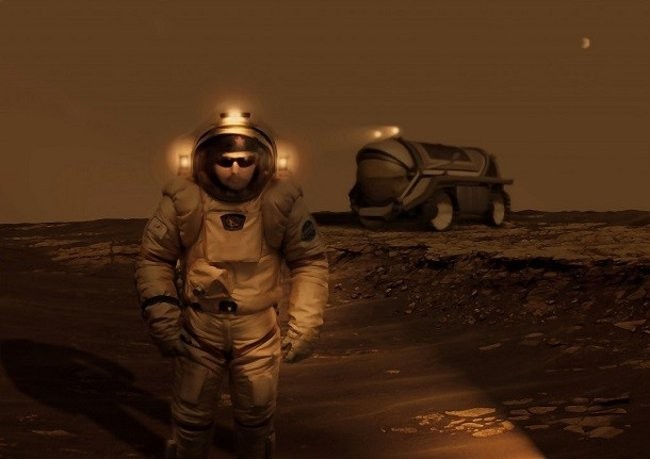
28. Mars has the most violent weather in the solar system, including powerful hurricanes, dust storms, and small tornadoes.
29. In 2001, a giant dust storm covered the entire planet Mars for several Earth days.
30. Mars has more storms as the planet gets closer to the Sun.
31. Mars has two moons, their names are Deimos and Phobos .
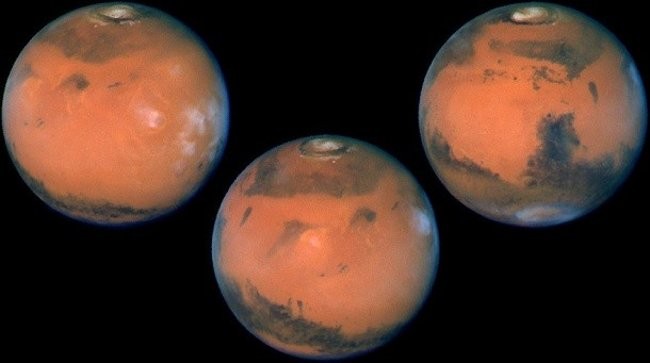
32. The orbit of the moon Phobos is very close to the atmosphere of Mars. This means that one day, the moon's gravity will crash into it and break it into many pieces. The pieces will be in the moon's orbit, forming a ring like the rings of Saturn .
33. Phobos and Deimos, named after the sons of Ares .
34. On November 13, 1971, Mariner 9 reached Mars and officially became the first artificial satellite in lunar orbit.
35. Mariner 9 was able to measure 100% of the Martian surface and took the first close-up pictures of the Martian moons Phobos and Deimos.
36. Mariner 9 took a total of 7,329 pictures of Mars and stayed in orbit for 349 days.
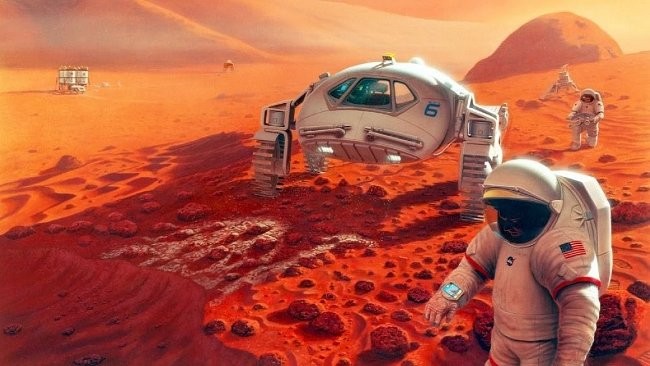
37. In 1976, the Viking 1 and 2 probes were the first spacecraft to successfully land on Mars.
38. When Viking 1 and 2 landed there, no one knew what the surface of Mars looked like.
39. The Mars Global Surveyor was the first successful mission to Mars in 20 years. It launched on November 7, 1996.
40. The Mars rover has taken thousands of pictures of Mars.
41. If you tried to set foot on the surface of the Moon without a space suit, you would definitely die instantly.
42. Mars is the fourth planet from the Sun and the seventh largest planet.
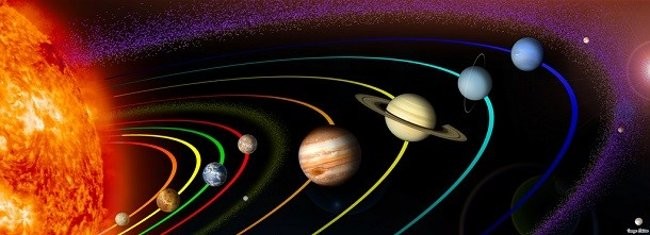
43. The largest volcano in the Solar System is on Mars, called Olympus Mons. In Latin it is Mount Olympus.
44. Mount Olympus Mons is 27 km high and 600 km wide, 8.85 km higher than Mount Everest.
45. Mount Olympus Mons is a shield volcano , meaning it can grow much larger because of lava flows erupting inside.
46. The word "March " in English comes from Mars.
47. The moon of Mars was discovered by an American astronomer named Asaph Hall in 1877.
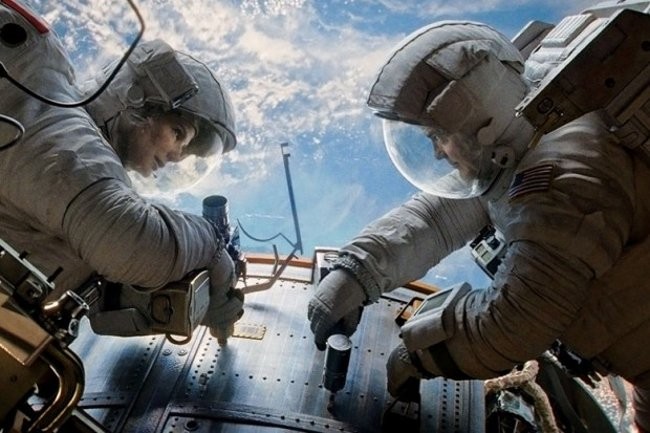
48. The diameter of Mars is about 6791 km.
49.The first spacecraft to visit Mars was Mariner 4 in 1965.
50. One year on Mars is equal to one year, 320 days and 18.2 hours on Earth.
51. The mission to Mars was launched in 2011. It is a larger and more advanced version of the Mars probe.
52. There are currently 12 man-made objects on Mars.
53. Scientists say they have found a human skull on Mars.
54. The distance from Mars to the Sun is 1.5 times that from Earth.
See also: SpaceX delays rocket launch to Mars until 2020
Have fun!
On September 14, NASA shared the most detailed image of the surface of Mars ever, along with a video that gives us a new and clearest panoramic view of the surface of the red planet.
NASA has big goals for Mars. The agency wants to collect the first samples from the Martian surface and return them to Earth in an ambitious mission called Mars Sample Return.
How big is Mars? Not only the area of Mars, the article will tell you more about the 4th planet - Mars.
How big is the diameter of the solar system? This article will give you the answer.
One of the world's leading energy corporations BP has recently signed an ambitious cooperation agreement with NASA, with the aim of applying advanced mining technology available on Earth to drill for hidden resources on the moon.
Scientists have photographed many strange things on Mars, from spoons, squirrels, blueberries to the shadow of a woman… but no one is sure if they are real or not.
At first glance, AirPods look just like any other true wireless earbuds. But that all changed when a few little-known features were discovered.
In this article, we will guide you how to regain access to your hard drive when it fails. Let's follow along!
Dental floss is a common tool for cleaning teeth, however, not everyone knows how to use it properly. Below are instructions on how to use dental floss to clean teeth effectively.
Building muscle takes time and the right training, but its something anyone can do. Heres how to build muscle, according to experts.
In addition to regular exercise and not smoking, diet is one of the best ways to protect your heart. Here are the best diets for heart health.
The third trimester is often the most difficult time to sleep during pregnancy. Here are some ways to treat insomnia in the third trimester.
There are many ways to lose weight without changing anything in your diet. Here are some scientifically proven automatic weight loss or calorie-burning methods that anyone can use.
Apple has introduced iOS 26 – a major update with a brand new frosted glass design, smarter experiences, and improvements to familiar apps.
Yoga can provide many health benefits, including better sleep. Because yoga can be relaxing and restorative, its a great way to beat insomnia after a busy day.
The flower of the other shore is a unique flower, carrying many unique meanings. So what is the flower of the other shore, is the flower of the other shore real, what is the meaning and legend of the flower of the other shore?
Craving for snacks but afraid of gaining weight? Dont worry, lets explore together many types of weight loss snacks that are high in fiber, low in calories without making you try to starve yourself.
Prioritizing a consistent sleep schedule and evening routine can help improve the quality of your sleep. Heres what you need to know to stop tossing and turning at night.
Adding a printer to Windows 10 is simple, although the process for wired devices will be different than for wireless devices.
Diet is important to our health. Yet most of our meals are lacking in these six important nutrients.
You want to have a beautiful, shiny, healthy nail quickly. The simple tips for beautiful nails below will be useful for you.
